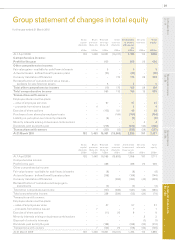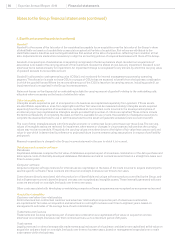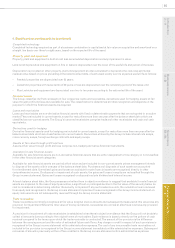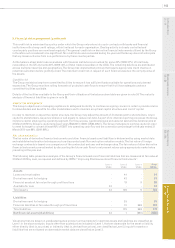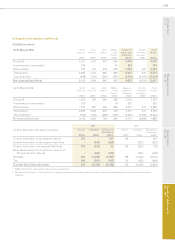Experian 2010 Annual Report Download - page 100
Download and view the complete annual report
Please find page 100 of the 2010 Experian annual report below. You can navigate through the pages in the report by either clicking on the pages listed below, or by using the keyword search tool below to find specific information within the annual report.
Experian Annual Report 2010 Financial statements98
Notes to the Group nancial statements (continued)
4. Signicant accounting policies (continued)
If the effect of the time value of money is material, provisions are determined by discounting the expected future cash ows at a
pre-tax rate that reects current market assessments of the time value of money and, where appropriate, the risks specic to the
liability. Where discounting is used, the increase in the provision due to the passage of time is recognised as an interest expense.
Where the Group expects a provision to be reimbursed, the reimbursement is recognised as a separate asset when the
reimbursement is virtually certain.
Leases
Finance leases
Leases of property, plant and equipment where the Group has substantially all the risks and rewards of ownership are classied
as nance leases. Such leases are capitalised at the lease’s inception at the lower of the fair value of the leased asset and
the present value of the minimum lease payments. Each lease payment is allocated between the liability and nance charges.
The rental obligations, net of nance charges, are included in loans and borrowings. The interest element of the lease payment
is charged in the Group income statement over the lease period so as to produce a constant periodic rate of interest on the
remaining balance of the liability for each year.
Operating leases
Leases in which a signicant portion of the risks and rewards of ownership are retained by the lessor are classied as operating
leases. Payments made under operating leases are charged in the Group income statement on a straight line basis over the
period of the lease. Incentives from lessors are recognised as a systematic reduction of the charge over the period of the lease.
Employee benets
Dened benet pension arrangements – funded plans
The retirement benet obligations recognised in the Group balance sheet in respect of funded plans comprise the fair value of
plan assets of funded plans less the present value of the related dened benet obligation at the balance sheet date, together
with adjustments for past service costs. The dened benet obligation is calculated annually by independent qualied actuaries
using the projected unit credit method.
The present value of the dened benet obligation is determined by discounting the estimated future cash outows using
market yields available at the assessment date on high-quality corporate bonds that are denominated in the currency in which
the benets will be paid, and that have terms to maturity consistent with the estimated average term of the related pension
liability.
Actuarial gains and losses arising from experience adjustments, and changes in actuarial assumptions, are recognised
immediately in the Group statement of comprehensive income.
Past service costs are recognised immediately in the Group income statement, unless the changes to the pension plan are
conditional on the employees remaining in service for a specied period of time (the vesting period). In this case, the past
service costs are amortised on a straight line basis over the vesting period.
The pension cost recognised in the Group income statement comprises the cost of benets accrued plus interest on the dened
benet obligation less the expected return on the plan assets over the year. The operating and nancing costs are recognised
separately in the Group income statement.
Dened benet pension arrangements – unfunded plans
Unfunded pension obligations are determined and accounted for in accordance with the principles used in respect of the funded
arrangements.
Dened contribution pension arrangements
The assets of dened contribution plans are held separately from those of the Group in independently administered funds. The
pension cost recognised in the Group income statement represents the contributions payable by the Group to these funds in
respect of the year.
Post-retirement healthcare obligations
Obligations in respect of post-retirement healthcare plans are calculated annually by independent qualied actuaries using an
actuarial methodology similar to that for the funded dened benet pension arrangements.
Actuarial gains and losses arising from experience adjustments, and changes in actuarial assumptions, are recognised in
the Group statement of comprehensive income. The pension cost recognised in the Group income statement only comprises
interest on the dened benet obligation.



